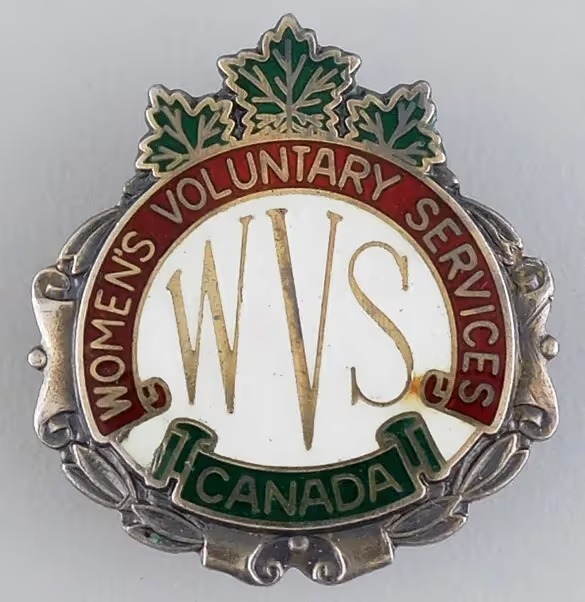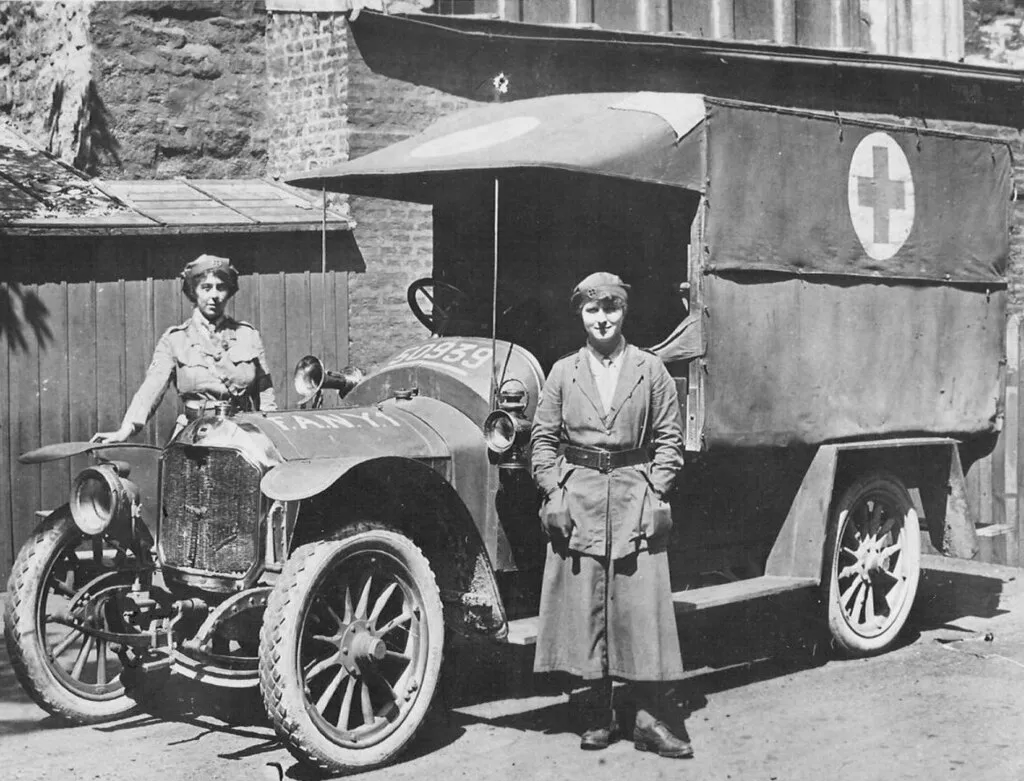Women's Voluntary Services (WVS) Canada, 1938-1966
Women's Voluntary Services (WVS) Canada
Women's Voluntary Services (WVS) Canada. The WVS was an organization instituted in 1938 and dedicated to providing much-needed war time relief efforts for civilian victims who had been evacuated or lost their homes. Based on a British model, the WVS served from 1938 to 1966 as a voluntary organization concerned with helping people in need and to help in the event of War. The WVS collected and distributed clothing from all over the world. In total over twenty million garments were distributed. The organization worked with the American and Canadian Red Cross to provide this relief. Between 1941 and 1945 the WVS collected three million garments, 85,000 sheets and bedding, 86,000 blankets, 350,000 quilts, 16,000 boots and shoes and 262 tons of jam from generous Canadians through the Canadian Red Cross. In addition, the WVS’s 12,000 volunteers collected money to purchase clothing and other garments.

(EMEDALS.com Photo)
Women's Volunteer Services Canada pin.
When Canada declared war in 1939, women felt obligated to help the fight. In October 1938, the Women’s Volunteer Service was established in Victoria, British Columbia. A recruitment event was held in hopes of gaining around 20 new volunteers; over 100 women arrived to join the efforts. Shortly after, more British Columbian women felt the need to do their part, and when the 13 corps joined together the BC Women’s Service Corps was created. Soon after, all the other Canadian provinces and territories followed suit and similar volunteer groups emerged.
In addition to the Red Cross, several volunteer corps had designed themselves after auxiliary groups from Britain. These corps had uniforms, marching drills and a few had rifle training. It soon became clear, that a unified governing system would be beneficial to the corps. The volunteers in British Columbia donated $2 each to pay the expenses so a representative could talk to politicians in Ottawa. Although all of the politicians appeared sympathetic to the cause, it remained 'premature' in terms of national necessity.
Canada was later in granting this permission than the rest of the Commonwealth. The British Mechanized Transport Corps had begun to see the women of Canada as a great asset to the war effort and began to look into the recruitment of these women for their purposes. In June 1941, they were officially given permission to recruit women in Canada for overseas duty. It quickly became apparent that it would look very odd for the British to be recruiting in Canada when there was no corresponding Canadian service. However, many of the women who were active in the various volunteer corps did not meet the requirements to be enlisted women. The majority of these women were older than the accepted age, would not pass the fitness test, or had physical or medical impairments. It was quickly realized that the women needed had jobs and were not free to join.

(Library and Archives Canada Photo, MIKAN No. 3382383)
Women's Voluntary Service assistant helping children with pasting at day nursery in the Givens Street School, Toronto, Ontario, February 1943. Not the armband.
Women's participation on the home front was essential to the war effort. The largest contribution by the majority of Canadian women was through unpaid volunteer work, through their domestic abilities and skills; women were able to support the nation and the war effort. The government called upon women to participate in volunteer programs. Women began collecting recycled items such as paper, metal, fat, bones, rags, rubber, and glass. Clothing was also collected by Canadian women for free distribution overseas. They also prepared care packages to send to the men and women overseas. Canadian women were responsible for maintaining the morale of the nation. All over Canada, women responded to demands made upon them by not only selling war savings stamps and certificates but purchasing them as well, and collecting money to buy bombers and mobile canteens.
Taylor M. Saunders found some related records on the women who supported Canada's war efforts in the Canadian Archives
Extracts from Report No. 68 Historical Section (G.S.) Army Headquarters. Manpower, Problems of the Women' s Services During the Second World War, 17 June 1954.
Women had been employed in various auxiliary capacities during The Great War of 1914-1919, with the Canadian Corps in France and Belgium; with Canadian troops in the United Kingdom and in Canada. During 1918 the Militia Council in Ottawa discussed the formation of a Canadian Women's Army Auxiliary C6rps (A.H. Q,. Report No. 15). No action was taken "then, however, nor in the years of peace that followed.
Although a Women's Corps had been formed for each of the Btitish Services, these had been disbanded after the Great War. However, a certain amount of interest continued. In 1934. This cullninated in the creation of a Women's Reserve Sub-committee of the Manpower Sub-committee of the Committee of Imperial Defence. In May 1936 this Sub-committee reported against the formation of a reserve of women in peacetime but its view was reversed during the winter of 1937-38, when the problem of augmenting the manpower resources of the United Kingdom became a matter of urgency. On 9 Sep 1938, Royal Assent was given a scheme to recruit 20 000 women between the ages of 18 and 50, into Auxiliary Territorial Service (ATS) companies of varying size; each to be commanded by a woman officer and affiliated to a unit of the Territorial Army (TA). During April 1939, the Admiralty took steps to create a Women's Royal Naval Service (WRNS). Then, On 28 Jun 1939 a Women's·Auxiliary Air Force (WAAF) was formed, initially from ATS companies which had been raised for duty with the Royal Air Force (RAF). These organizations initially comprised volunteers only and were auxiliaries to, rather than part of the Armed Forces of the crown.
Note: Although they had no connection with the Armed Forces of the United Kingdom during the Second World War, 'thousands ot British women· served wi th the Women' s Land Army (WLA), Mechanized Transport Corps (MTC), Air Transport Auxiliary (ATA), National Fire Service (NFA), Civil Nursing Reserve (CNR), Red Cross Society (RCS), St. John' s Ambulance Brigade (SJAB), Britisn Legion and the Women's Voluntary Services (WVS) for Civil Defence. Although the Women' s Transport Corps/First Aid Nursing Yeomanry (FANY) provided Motor Driver Companies for the ATS, it also continued its separate existence throughout.
The first voluntary, self-designated corps of Canadian women had been formed in Victoria, British Columbia, during October 1938. Once war broke out in 1939 more Canadian women showed a desire to emulate the example of British women and unofficial corps mushroomed across the country. Among these were the Canadian Red Cross Corps (CRCC), the Women's Transport Service Corps (WTSC), the Alberta Women's Service·Corps (AWSC), the Canadian Auxiliarv Territorial Service (CATS) (Ontario) ·the Women's Voluntary Reserve Corps WVRC) (Montreal and Quebec, the Saskatchewan Auxiliary Territorials (SAT), the Nova Scotia Women's Service Corps (NSWSC), and the Britisfi Columbia Women's Service Corps (BCWSC). {AHQ Report No. 15).
Most of these corps applied for official recognition but this was refused. National Defence Headquarters (NDHQ) was alive to the fact that it was becoming increasingly difficult to find suitable men for employment as clerks, cooks, mess waiters, canteen workers and the like, but as the Adjutant General pointed out in a memorandum circulated to the heads of the other branches on 26 Aug 1940: ...owing to the jealous claims which will undoubtedly be put forward by these organizations if given recognition, it will ·not be possible to utilize these "Corps", as such, either in whole or in part. The establishment of an entirely new Corps with open recruiting will be the only satisfactory method for some time to come. He suggested that the first step would to recruit women to replace men in Canada as clerks at NDHQ Military District Headquarters (MDHQ) and training establishments and as cooks, canteen helpers and mess waitresses at training centres. Unless temporary female civil servants wished to enrol, they would be replaced by women in uniform.
This documnet went on to describe the discussions, plans and eventual implementation of enrollment of Women to serve in uniform in the Canadian Armed Forces during the Second World War.
Notes

The First Aid Nursing Yeomanry (Princess Royal's Volunteer Corps) (FANY (PRVC)) is a British independent all-female registered charity structured like a military reserve unit. which primarily provides surge relief to civil and military authorities in an emergency. It was formed in 1907 and was active in both nursing and intelligence work during the World Wars.While its members wear British military-style uniforms and ranks, as well as having a close affiliation to the British Army, it is not part of the Regular Army, or Army Reserve, nor is it part of any branch of the Armed Forces, its members are designated as civilians. Their officers do not train at Sandhurst nor do they hold the King's commission. Its members are unpaid volunteers who pay membership fees to the charity to take part in training and qualifications. (Wikipedia)

(IWM Photo)
Lieutenant Grace "Mac" Mcdougall and the Ford FANY ambulance named "Flossie" in Calais in 1915 with "Bob" Bailey.

